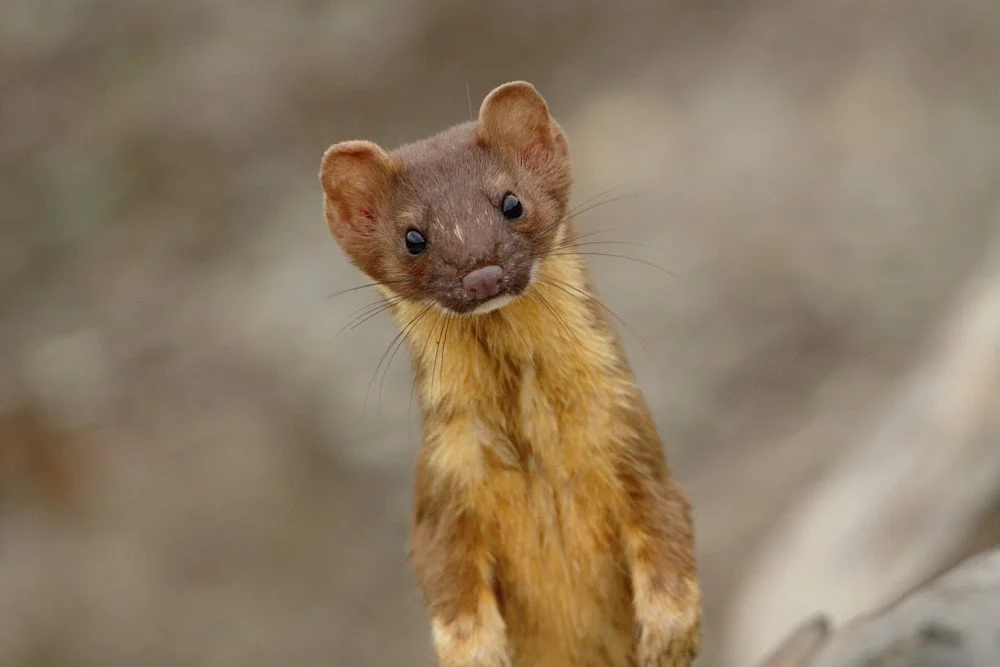Long-tailed weasel
Scientific Name: Mustela frenata
The long-tailed weasel is a slender, energetic predator found across most of North America. They have a small, narrow head with long whiskers. It is the largest weasel species in New York and is known for its bold behavior and fierce hunting skills.
It has brown pelage during the summer (with white belly and under chin) and white pelage during the winter except for a few populations in the state that retain their brown pelage year-round. The fur is composed of short, soft underfur covered by shiny guard hair. They have relatively short legs compared to their long body. Namely, it’s tail is quite long, accounting for half of its total body length.
Adult size: 12 to18 in
Weight: 73 to 270 grams
Life span: Up to 5 years in the wild
Maturity: females breed their first year, while males generally wait till their second year
Litter size: 1-12 (average 5)
Fun Fact
Often described as a voracious eater, the long-tailed weasel eats 20-30% of its body weight every day!
Diet
The long-tailed weasel’s diet largely consists of mice and voles, with a variety of other small mammals (and sometimes larger ones!) consumed including shrews, moles, squirrels, chipmunks, rabbits, hares, invertebrates, frogs, snakes, birds, and eggs.
They are a generalist and can shift their diet depending on prey availability.
Habitat
Long-tailed weasels can also be considered a habitat generalist. They use a variety of habitats with high cover and abundant prey. They are more often found at elevations below 2000 ft in woodlands, shrublands, and hedgerows.
They may be less abundant in very dense, closed-canopy forests and at higher elevations.
Behavior
They often search for prey in what may appear to be an erratic and hurried pattern scouring the environment for any sign of small rodents. They quickly search every rock crevice, log, and around each burrow in pursuit of prey. They may also climb trees, swim, and burrow in snow. They may cache prey near their burrow for future use. This voracious appetite and uncanny ability to seek out prey occasionally leads them to take domestic chickens or eggs.
The long-tailed weasel may den in old burrows of other animals and maintain several dens throughout their large home range of 75-100 acres. They may be active at any time day or night.
Reproduction and Life Cycle
Individuals are solitary until the breeding season where they form temporary pairs. They breed in the mid summer months (July and August). After copulation, implantation of the egg is delayed, and does not begin to develop until march, making the gestation period around 280 days! Most of the fetus growth occurs in the last month of pregnancy.
They give birth in early-mid spring, with an average of 6 offspring. New born weasel are tiny, weighing only 3 grams. They are born helpless, with closed eyes, and pink, wrinkled skin, white sparse white fur. Their fur begins to thick around 2 weeks after birth. They are weaned by 36 days, and learn how to kill prey on their own by 56 days old. Soon after this, they become completely independent. Females will mate during their first summer, but males wait until the following spring.
Population Status
Long-tailed weasels are listed as “least concern” on the IUCN red list. This means they are fairly common and widespread throughout their range.
Viewing
Their small size, tendency to stay near cover and fast speed make them difficult to spot, but they can be found statewide.
Range
The exact distribution in the state is unknown but they likely occupy most of the state except for densely populated urban regions lacking habitat.
For more information on Long-tailed weasel in New York please visit the NYSDEC page here.





